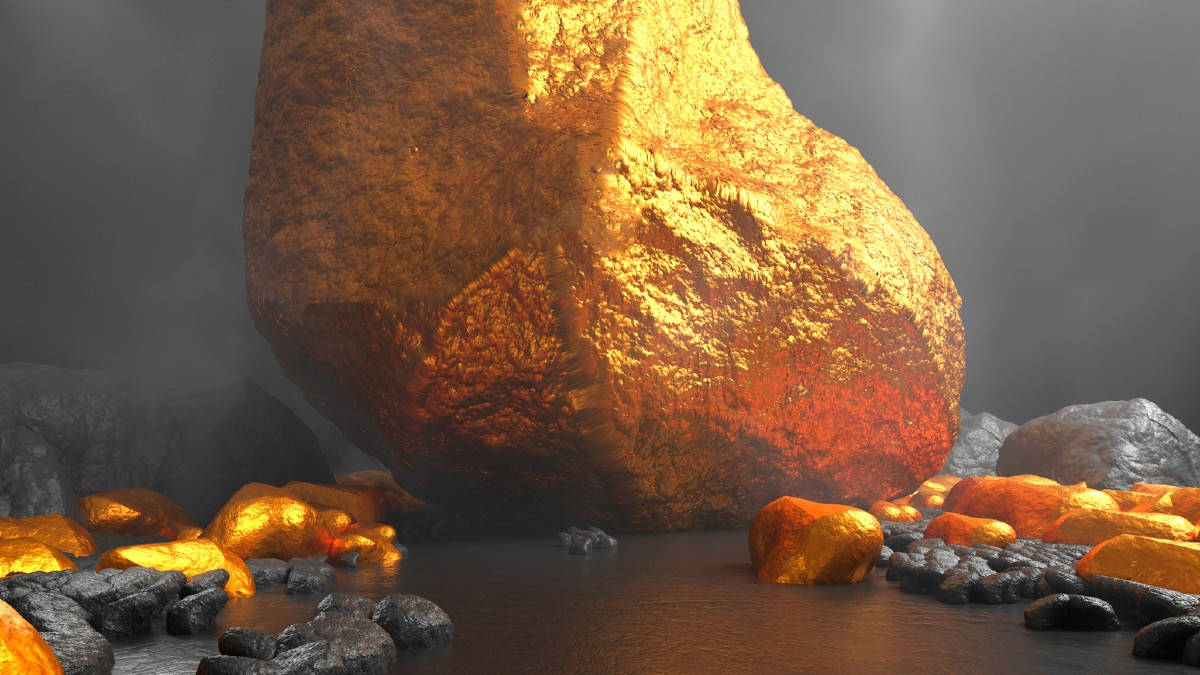Trading with Focus – The best mine in the world

Pic: Getty
I love finding an image, like the one pictured, that perfectly explains a hard-to-understand concept.
No doubt the geologists and explorers and speccy mining investors would disagree, but wouldn’t it be cool if that was how mining actually worked!
But it doesn’t. You need to drill holes into the ground, crush it up, then send it to a lab. Once you have enough holes drilled, and enough data, you can call it a resource to the global JORC standards. Then you have to prove you can mine it, get it treated, and sent to the people who will turn it into money.
You then have to work out how much money you would make, over a certain period of time, taking into account the volatility of the underlying commodity price and the exchange rates. Even labour costs, fuel costs, explosive costs and shipping costs can fluctuate wildly, so first you have a stab at a ‘Pre-Feasibility Study’ to see if it’s all worthwhile
Get your JORC standards up high enough, with enough holes, and prove that the rock can be turned into something better than ‘ground up rock’ and then you can start talking about offtake agreements and funding with a ‘Definitive Feasibility Study’, where you have to work out every single cost – from the cost of every single nut and bolt to what sort of meal the workers would have on a Tuesday in July, three years from now.
But not before you’ve got your mining approvals, water plan, Native Title agreements and more all locked down.
So there’s a lot more to it than scraping off the topsoil to find a big fat gold nugget.
Earlier stage mining investment is a little different too. There might be a few billion dollars worth of copper or whatever in the pit.
But you have to take into account that the difference between a viable mine and a non-viable mine could be as simple as a 10% move in the commodity price, or some weird spider-like thing that only lives in the soil directly above your future pit.
Or in the case of some of the unstable regions that are yet to be fully exploited by modern mining – a helicopter gunship flying in to tell you that the latest coup leader wants you to leave, because it’s all his now.
You also have to understand that throughout all of this, the company is spending money and that pile of money will need to be replenished many, many times before creating money of its own – if indeed it ever does.
There are a few hints in the stockmarket that you can look out for, to tell you whether you’re got ‘the goose that laid the golden egg’ (as pictured), or the ‘hole in the ground to shovel money into’. Here’s a list off the top of my head:
- Management that are as hungry as you to make it work
- A good stable country
- Shallower is better than deeper
- Higher grade, unless it’s an absolute monster
- Roads, rail, power, water, ports
- A market for the end product
- No beautiful landscapes, no rivers, no heritage and no locals!
The long and short of it is that there is no perfectly safe mining company. Even the big blue ones like BHP can take a pounding, but at least they are diversified and profitable. A bad cycle hurts BHP in the short run, but they can probably recover in the next one.
But a speccy miner can wipe you out completely as their projects can fail from no fault of their own, and they still need to raise cash regularly – even if they’ve already dropped to the value of a shell company.
So don’t fall in love with a speccy explorer.
If you choose to invest though, make sure to read all of their news. Collect all of their research. Listen to all of the analysts’ opinions. Look into management’s ability. Watch the charts for indications, compare to the underlying commodities and look to see who else is backing your play.
Then take it all with a bucket of salt, because mostly you’re just riding blind hoping that it all comes off.
At Marketech our platform is about technology, providing you the tools and technology to trade. We encourage our high-function trading platform to get you live pricing, live charts, live market depth to ensure you have the tools and trading capability at your fingertips, and on your mobile phone or PC.
You trade your own stock on your individual HIN. It is your cash in your own Macquarie account where you keep the competitive interest you earn.
Our subscribers get access to brokerage starting at $5, and then 0.02 per cent for trades over $25k. If you want to trade the market, you need immediate access wherever you are and the seamless Marketech mobile app means you are live anywhere anytime.
Marketech Focus subscribers also get 2-months free access to the ‘Marcus Today’ newsletter to help you with your investing and trading goals.
For more information, visit www.marketech.com.au. Any queries regarding Marketech should be directed to Marketech and not to Stockhead.
This article was developed in collaboration with Marketech Online Trading Pty Ltd (ACN 654 674 432), an Authorised Representative (1293528) of Sanlam Private Wealth Pty Ltd (AFSL 337927), and a Stockhead advertiser at the time of publishing.
All information and material contained herein is general in nature and does not consider your financial situation, investment needs or objectives.
The information does not constitute personal financial advice, nor a recommendation or opinion that a security or service is appropriate for you.
You should seek independent and professional tax and financial advice before making any decision based on this information.
UNLOCK INSIGHTS
Discover the untold stories of emerging ASX stocks.
Daily news and expert analysis, it's free to subscribe.
By proceeding, you confirm you understand that we handle personal information in accordance with our Privacy Policy.








